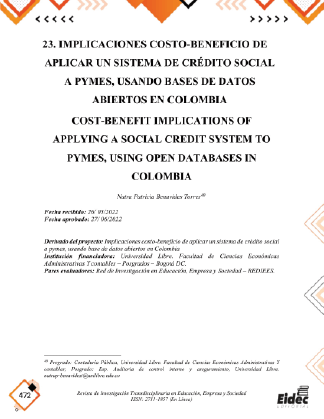XXIII. COST-BENEFIT IMPLICATIONS OF APPLYING A SOCIAL CREDIT SYSTEM TO PYMES, USING OPEN DATABASES IN COLOMBIA
##plugins.themes.bootstrap3.article.main##
Abstract
In this work, an investigation and analysis of the main challenges of the credit system in
Colombia was conducted, allowing us to compare them to propose a structure based on the
theory of Chinese Social Credit (SCS) and its approach in the management of Big Data tools.
Supported by ICTs, which allow us to monitor and predict the reliability and risk most
adapted to the reality of all users, to conduct a multicriteria analysis that allows us to observe
the multidimensional costs and benefits. Identifying variables that allow knowing and
understanding the population to offer financing products that adjust to their realities.
Colombia is a country that has made great progress in terms of financial inclusion; however,
it still has great challenges to overcome, the entities that grant credits continue to base their
decisions on traditional criteria, excluding a large group of applicants.
The financial health of people depends on the financial education they have, since it was
found that the degree of financial illiteracy that the population has is high, which prevents
access to credit.
The cost-benefit analysis that was conducted on the model as the final objective of this work
shows that the significant improvement plan conducted a high degree of investment in
research and technology, but it solves most of the challenges posed for the credit system.
Colombian and provides opportune socioeconomic welfare for entrepreneurs.
Download Statistics
##plugins.themes.bootstrap3.article.details##
SCS social credit system, ICT information technology, Small and medium-sized PYMES, Big Data, cost-benefit.
empresas deben saber. China.
Álvarez, S. (2009). Piensa en el costo-beneficio de la tecnología. EL EMPRESARIO.
Bernal, C. (2016). Metodologia de la Investigacion. Colombia: Pearson.
Caballero Lopez, J. E. (09 de 2009). http://scielo.isciii.es. Obtenido de
http://scielo.isciii.es/pdf/mesetra/v55n216/revision.pdf
CASTELLANOS OSPINA, V., & CERON QUINTERO, D. (2020). MEDELLIN.
Castrillón García, L., & Galeano Ruiz, B. S. (2019). LAS CENTRALES DE RIESGO Y SU
PAPEL EN EL SISTEMA FINANCIERO. Medellin.
CHINA, B. (2019). Sistema de crédito social corporativo de China: lo que las empresas deben
saber. CHINA BRIEFING Reunión informativa sobre China.
Decreto 663 de 1993. (1993). Estatuto Orgánico del Sistema Financiero. COLOMBIA.
Departamento de Estado CHINA. (17 de JUNIO de 2014). Circular del Consejo de Estado
sobre la Impresión y Distribución del Esquema del Plan para la Construcción del
Sistema de Crédito Social. Guo Fa [2014] No. 21: http://www.gov.cn/index.htm.
Obtenido de http://www.gov.cn/index.htm:
http://www.gov.cn/zhengce/content/2014-06/27/content_8913.htm
John, A. (2016). Normas Basicas de Higiene del Entorno en la atención sanitaria. India:
Organizacion Mundial de la Salud. Obtenido de
http://apps.who.int/iris/bitstream/handle/10665/246209/9789243547237-
spa.pdf;jsessionid=98A5D7C69806F077F4D7F5B862DCA0BB?sequence=1
Rodriguez-Novoa, D., Yanquen, E., & Botero, O. (2020). Reporte de la situación del crédito
en Colombia - Diciembre de 2020. Repositorio BanRep, 58.
SFC. (2019). REPORTE DE INCLUSION FINANCIERA.
Sumit, A., Shashwat Alok, S., Pulak, G., & Gupta, S. (2019). Financial Inclusion and
Alternate Credit Scoring: Role of Big Data and Machine Learning in Fintech. Indian
School of Business, 85.
Uribe, J. D. (2013). El sistema financiero colombiano:estructura y evolución reciente. Revista
Banco de la República , 1-3.
Xan Wong, K. L., & Shields Dobson, A. (2019). We’re just data: Exploring China’s social
credit system in relation to digital platform ratings cultures in Westernised
democracies. Global Media and China.





